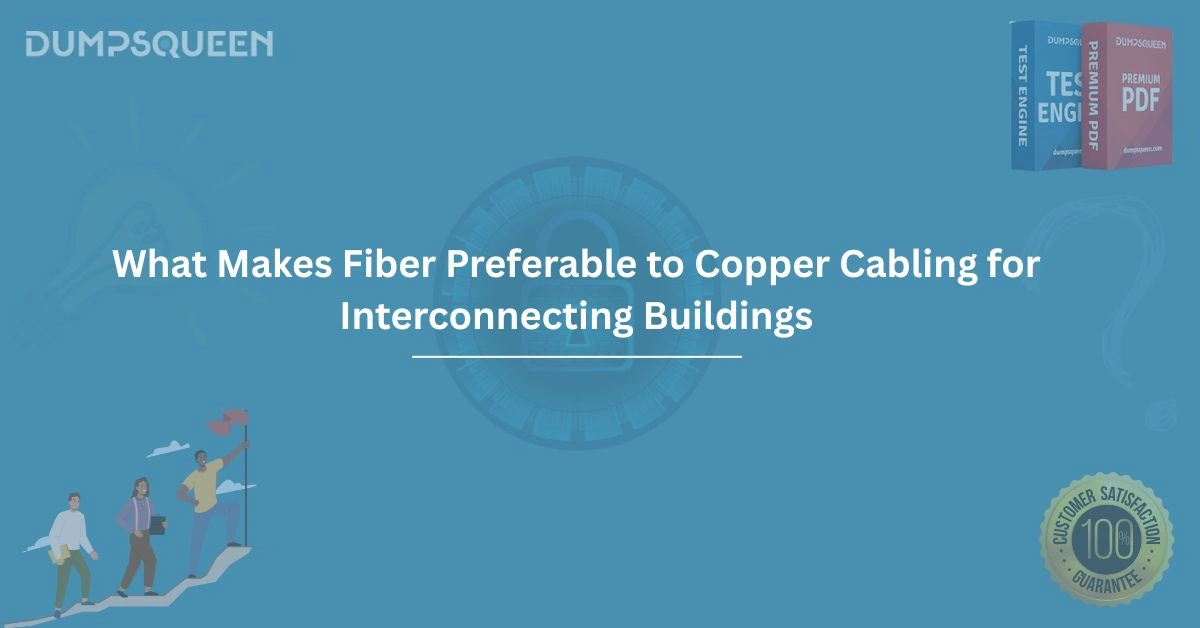Introduction
In the rapidly evolving world of telecommunications and networking, the choice of cabling infrastructure plays a pivotal role in determining the efficiency, reliability, and scalability of data transmission systems. As businesses and institutions increasingly rely on high-speed, secure, and robust connectivity to interconnect buildings, the debate between fiber optic and copper cabling has gained significant attention. While copper cabling has been a staple in networking for decades, fiber optic cabling has emerged as the superior choice for modern interconnectivity needs. This blog explores the reasons why fiber optic cabling is preferable to copper cabling for interconnecting buildings, highlighting its technical advantages, cost-effectiveness, and future-proofing capabilities. At DumpsQueen, we aim to provide valuable insights into cutting-edge technologies to empower professionals and organizations in making informed decisions. Visit the DumpsQueen for more resources and expert guidance.
Superior Bandwidth and Data Transmission Speeds
One of the most compelling reasons to choose fiber optic cabling over copper for interconnecting buildings is its unparalleled bandwidth and data transmission speeds. Fiber optic cables transmit data using light signals through thin strands of glass or plastic, allowing them to carry significantly more data than copper cables, which rely on electrical signals. This capability is critical in environments where large volumes of data, such as high-definition video streams, cloud-based applications, and real-time analytics, need to be transmitted between buildings.
Fiber optic cables can support speeds ranging from 10 Gbps to 100 Gbps and beyond, depending on the type of fiber and equipment used. In contrast, copper cables, such as Category 6 or 6A Ethernet cables, typically max out at 10 Gbps over shorter distances. For organizations requiring high-speed connectivity to support data-intensive operations, fiber optics provide a robust solution that meets current demands and accommodates future growth. By leveraging fiber optic cabling, businesses can ensure seamless communication and data transfer, enhancing productivity and operational efficiency.
Greater Transmission Distances Without Signal Degradation
When interconnecting buildings, the distance between connection points is often a significant consideration. Copper cabling is limited by its susceptibility to signal degradation over long distances. For instance, Ethernet over copper typically supports reliable data transmission up to 100 meters (328 feet). Beyond this distance, signal loss and interference can compromise performance, necessitating the use of repeaters or additional equipment to boost the signal.
Fiber optic cabling, on the other hand, excels in long-distance data transmission. Single-mode fiber optic cables can transmit data over distances of up to 40 kilometers (25 miles) or more without significant signal loss, making them ideal for interconnecting buildings across large campuses, industrial complexes, or metropolitan areas. Even multimode fiber, which is commonly used for shorter distances, can support reliable transmission over several hundred meters. This extended reach reduces the need for additional infrastructure, simplifying network design and lowering installation costs. For organizations seeking reliable, long-distance connectivity, fiber optic cabling is the clear choice.
Immunity to Electromagnetic Interference
Another significant advantage of fiber optic cabling is its immunity to electromagnetic interference (EMI). Copper cables, which transmit data via electrical signals, are highly susceptible to EMI from sources such as power lines, heavy machinery, or nearby electronic devices. In environments with high levels of electromagnetic noise, such as industrial facilities or densely populated urban areas, copper cabling may experience signal distortion or data loss, leading to unreliable network performance.
Fiber optic cables, by contrast, use light to transmit data and are entirely immune to EMI. This characteristic ensures consistent and reliable data transmission, even in challenging environments. For organizations interconnecting buildings in areas with significant electrical activity, fiber optic cabling provides a stable and dependable solution that minimizes disruptions and maintains network integrity. At DumpsQueen, we recognize the importance of reliable connectivity, and our resources can guide you in selecting the right cabling solutions for your needs.
Enhanced Security for Sensitive Data
Data security is a top priority for organizations transmitting sensitive information between buildings. Copper cabling is vulnerable to eavesdropping, as electrical signals can be intercepted using specialized equipment. This vulnerability poses a significant risk in applications where data privacy and security are paramount, such as financial institutions, healthcare facilities, or government agencies.
Fiber optic cabling offers a higher level of security because it does not emit electromagnetic signals that can be easily intercepted. Tapping into a fiber optic cable requires physically accessing the cable and splicing it, which is a complex and detectable process. Additionally, any attempt to tamper with a fiber optic cable typically results in noticeable signal loss, alerting network administrators to potential security breaches. By choosing fiber optic cabling, organizations can protect their data from unauthorized access and ensure compliance with stringent security regulations.
Lower Latency for Real-Time Applications
In today’s digital landscape, low latency is critical for real-time applications such as video conferencing, online gaming, and cloud computing. Latency refers to the time it takes for data to travel from one point to another, and even minor delays can impact user experience and operational efficiency. Fiber optic cabling offers lower latency than copper cabling due to the speed of light-based transmission and the absence of electrical resistance.
For organizations interconnecting buildings to support latency-sensitive applications, fiber optic cabling provides a significant advantage. For example, in a campus environment where multiple buildings rely on a centralized data center, fiber optics ensure rapid data transfer with minimal delays, enabling seamless collaboration and communication. By investing in fiber optic infrastructure, businesses can deliver superior performance for real-time applications, enhancing user satisfaction and productivity.
Durability and Reliability in Harsh Environments
The physical properties of fiber optic cables make them more durable and reliable than copper cables, particularly in harsh or outdoor environments. Copper cables are prone to corrosion, especially when exposed to moisture, chemicals, or extreme temperatures. This susceptibility can lead to performance degradation or cable failure over time, requiring costly repairs or replacements.
Fiber optic cables, made from glass or plastic, are highly resistant to environmental factors such as moisture, temperature fluctuations, and chemical exposure. They are also lighter and more flexible than copper cables, making them easier to install in challenging settings, such as underground conduits or aerial installations between buildings. Additionally, fiber optic cables are less likely to suffer from physical wear and tear, ensuring long-term reliability and reducing maintenance costs. For organizations seeking a robust and resilient cabling solution, fiber optics offer unmatched durability.
Cost-Effectiveness Over the Long Term
While the initial installation cost of fiber optic cabling may be higher than that of copper cabling, it offers significant cost savings over the long term. The superior bandwidth, longer transmission distances, and reduced maintenance requirements of fiber optics translate into lower operational costs. For example, the extended reach of fiber optic cables eliminates the need for additional equipment, such as repeaters or amplifiers, which are often required for copper-based networks.
Furthermore, fiber optic cabling is a future-proof investment that can support emerging technologies and increasing data demands without requiring frequent upgrades. As organizations continue to adopt bandwidth-intensive applications, such as 5G, Internet of Things (IoT), and artificial intelligence, fiber optics provide the scalability needed to accommodate these advancements. By choosing fiber optic cabling, businesses can avoid the recurring costs of replacing outdated copper infrastructure, ensuring a strong return on investment.
Scalability for Future Network Growth
As organizations grow and their networking needs evolve, scalability becomes a critical factor in choosing cabling infrastructure. Fiber optic cabling offers unmatched scalability, allowing businesses to expand their networks without significant modifications to the existing infrastructure. The high bandwidth capacity of fiber optics supports the addition of new devices, applications, and users without compromising performance.
In contrast, copper cabling has limited scalability due to its lower bandwidth and distance constraints. Upgrading a copper-based network to accommodate higher speeds or longer distances often requires replacing cables or installing additional equipment, which can be costly and disruptive. Fiber optic cabling, with its ability to handle future technological advancements, provides a flexible and scalable solution that supports long-term growth. For organizations planning to interconnect buildings with an eye toward future expansion, fiber optics are the ideal choice.
Environmentally Friendly and Energy Efficient
In an era where sustainability is a key consideration, fiber optic cabling offers environmental benefits over copper cabling. Fiber optic cables consume less energy during data transmission because they do not rely on electrical signals, which require more power to maintain signal integrity over long distances. This energy efficiency translates into lower operational costs and a reduced carbon footprint for organizations.
Additionally, fiber optic cables are made from abundant materials, such as silica, which are less resource-intensive to produce than copper. The durability and long lifespan of fiber optics also mean less frequent replacements, reducing waste and environmental impact. By choosing fiber optic cabling, organizations can align their networking infrastructure with sustainability goals while maintaining high performance.
Conclusion
In the quest for reliable, high-speed, and future-proof connectivity, fiber optic cabling stands out as the superior choice for interconnecting buildings. Its advantages over copper cabling—ranging from higher bandwidth and longer transmission distances to enhanced security and environmental sustainability—make it an essential component of modern networking infrastructure. While copper cabling may still have a place in certain applications, fiber optics offer the performance, reliability, and scalability needed to meet the demands of today’s data-driven world. By investing in fiber optic cabling, organizations can build robust and efficient networks that support current operations and pave the way for future growth. For more insights into networking technologies and professional development resources, explore the DumpsQueen, your trusted partner in achieving technological excellence.
Free Sample Questions
-
What is a key advantage of fiber optic cabling over copper cabling for long-distance data transmission?
a) Higher susceptibility to electromagnetic interference
b) Ability to transmit data over longer distances without signal degradation
c) Lower bandwidth capacity
d) Increased latency for real-time applications
Answer: b) Ability to transmit data over longer distances without signal degradation -
Why is fiber optic cabling considered more secure than copper cabling?
a) It emits electromagnetic signals that are easy to intercept
b) It requires frequent maintenance to ensure security
c) It is immune to eavesdropping due to light-based transmission
d) It is more susceptible to physical tampering
Answer: c) It is immune to eavesdropping due to light-based transmission -
How does fiber optic cabling contribute to cost savings over time?
a) By requiring frequent upgrades to support new technologies
b) By eliminating the need for additional equipment like repeaters
c) By increasing energy consumption during data transmission
d) By limiting scalability for future growth
Answer: b) By eliminating the need for additional equipment like repeaters -
What makes fiber optic cabling more environmentally friendly than copper cabling?
a) Higher energy consumption during data transmission
b) Use of resource-intensive materials like copper
c) Lower energy consumption and longer lifespan
d) Increased susceptibility to corrosion
Answer: c) Lower energy consumption and longer lifespan



